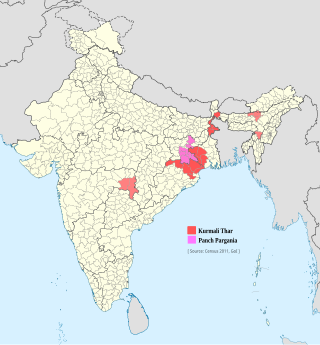
Odia is an Indo-Aryan language spoken in the Indian state of Odisha. It is the official language in Odisha, where native speakers make up 82% of the population, and it is also spoken in parts of West Bengal, Jharkhand, Andhra Pradesh and Chhattisgarh. Odia is one of the many official languages of India; it is the official language of Odisha and the second official language of Jharkhand.
Bihari languages is a group of the Indo-Aryan languages. The Bihari languages are mainly spoken in the Indian states of Bihar, Jharkhand, Uttar Pradesh, and West Bengal, and also in Nepal. The most widely spoken languages of the Bihari group are Bhojpuri, Magahi and Maithili.

Maithili is an Indo-Aryan language spoken in parts of India and Nepal. It is native to the Mithila region, which encompasses parts of the Indian states of Bihar and Jharkhand as well as the Nepalese Koshi and Madhesh Provinces. It is one of the 22 official languages of India. It is the second most commonly spoken language of Nepal. It is also one of the fourteen provincial official languages of Nepal. It was once described by linguist Sir George Abraham Grierson as the "sweetest language".

Bhojpuri is an Indo-Aryan language native to the Bhojpur-Purvanchal region of India and the Terai region of Nepal. It is chiefly spoken in eastern Uttar Pradesh, western Bihar and northwestern Jharkhand. It is an eastern Indo Aryan language and as of 2000 is spoken by about 5% of India's population. Bhojpuri is a descendant of Magadhi Prakrit and is closely related to Maithili, Magahi, Bangla, Odia, Assamese, etc. languages.

Santali, Bengali: সাঁওতালী, Odia: ସାନ୍ତାଳୀ, Devanagari: संताली, also known as Santal or Santhali, is the most widely-spoken language of the Munda subfamily of the Austroasiatic languages, related to Ho and Mundari, spoken mainly in the Indian states of Assam, Bihar, Jharkhand, Mizoram, Odisha, Tripura and West Bengal by Santals. It is a recognised regional language of India per the Eighth Schedule of the Indian Constitution. It is spoken by around 7.6 million people in India, Bangladesh, Bhutan and Nepal, making it the third most-spoken Austroasiatic language after Vietnamese and Khmer.

Magahi, also known as Magadhi, is a Indo-Aryan language spoken in Bihar, Jharkhand and West Bengal states of eastern India, and in the Terai of Nepal. Magadhi Prakrit was the ancestor of Magahi, from which the latter's name derives.

The Hindi Belt, also known as the Hindi Heartland, is a linguistic region encompassing parts of northern, central, eastern, and western India where various Northern, Central, Eastern and Western Indo-Aryan languages are spoken, with Hindi as the lingua franca.

Giridih district is one of the twenty-four districts of Jharkhand state, India, and Giridih is the administrative headquarters of this district. As of 2011 it is the third most populous district of Jharkhand, after Ranchi and Dhanbad.
Mal Paharia is a language spoken by 51,000 of 110,000 ethnic Mal Paharia in the states of Jharkhand and West Bengal in India, and regions of Bangladesh. The language is also known as Mal Pahoria, Malto, Malti, Paharia, Parsi, and Mal Pahariya. It has been variously regarded as a Bengali–Assamese language, a dialect of Malto, and a mixed Dravidian–Indo-Aryan language. There is a generally positive attitude among speakers of the language towards it, but it is considered vulnerable as some speakers have shifted to Bengali. Mal Paharia uses the Devanagari script and rules for its writing, reading, and speech.

Nagpuri is an Indo-Aryan language spoken in the Indian states of Jharkhand, Chhattisgarh, Odisha and Bihar. It is primarily spoken in the west and central Chota Nagpur plateau region. It is sometimes considered a dialect of Bhojpuri.
Bajjika (Western Maithili) is an Indo-Aryan language variety spoken in parts of Bihar, India and in Nepal. It is closely related to Maithili (of which it is often considered a dialect).
Asuri is an Austroasiatic language spoken by the Asur people, part of the Munda branch. Asuri has many Dravidian loanwords due to contact with Kurukh.

The Eastern Indo-Aryan languages, also known as Māgadhan languages, are spoken throughout the eastern region of the subcontinent, which includes Bihar, Uttar Pradesh, Jharkhand, Bengal region, Tripura, Assam, and Odisha; alongside other regions surrounding the northeastern Himalayan corridor. Bengali is official language of Bangladesh and the state of West Bengal, Tripura and the Barak valley of Assam while Assamese and Odia are the official languages of Assam and Odisha, respectively. The Eastern Indo-Aryan languages descend from Abahattha, which descends from Magadhan Apabhraṃśa and ultimately from Magadhi Prakrit.

Kurmali or Kudmali is an Indo-Aryan language classified as belonging to the Bihari group of languages spoken in eastern India. As a trade dialect, it is also known as Panchpargania, for the "five parganas" of the region it covers in Jharkhand. Kurmali language is spoken by around 5.5 lakh people mainly in fringe regions of Jharkhand, Odisha and West Bengal, also a sizeable population speak Kurmali in Assam tea valleys. Intellectuals claim that Kurmali may be the nearest form of language used in Charyapada. Charyapada are used and understood by the common Kurmis. This was the regional form of Kurmali Language. Kurmali is one of the demanded languages for enlisting in Eighth Schedule to the Constitution of India.
Most of the languages of Bihar, the third most populous state of India, belong to the Bihari subgroup of the Indo-Aryan family. Chief among them are Bhojpuri, spoken in the west of the state, Maithili in the north, Magahi in center around capital Patna. Maithili has official recognition under the Eighth Schedule to the Constitution of India. The official language of Bihar is Modern Standard Hindi, with Standard Urdu serving as a second official language in 15 districts.

Angika is an Eastern Indo-Aryan language spoken in some parts of the Indian states of Bihar and Jharkhand, as well as in parts of Nepal.
The state of Jharkhand in India is located in the eastern part of the country and is known for its vivid culture, distinct paintings, traditions and festivals.
The Nagpuria people, also Nagpuri or Sadan, are an Indo-Aryan speaking ethnolinguistic group who are the native speakers of the Nagpuri language and natives of the western Chota Nagpur Plateau region of Indian states of Jharkhand, Bihar, Chhattisgarh and Odisha.
Sadan are the native Indo-Aryan-speaking ethnolinguistic groups of Chota Nagpur Plateau consist of Indian state of Jharkhand and neighbouring states who speak Nagpuri, Khortha and Kurmali language as their native language.
The Sadanic languages are Bihari languages in the Indo-Aryan languages. The languages are mostly spoken in the Jharkhand state of India.











